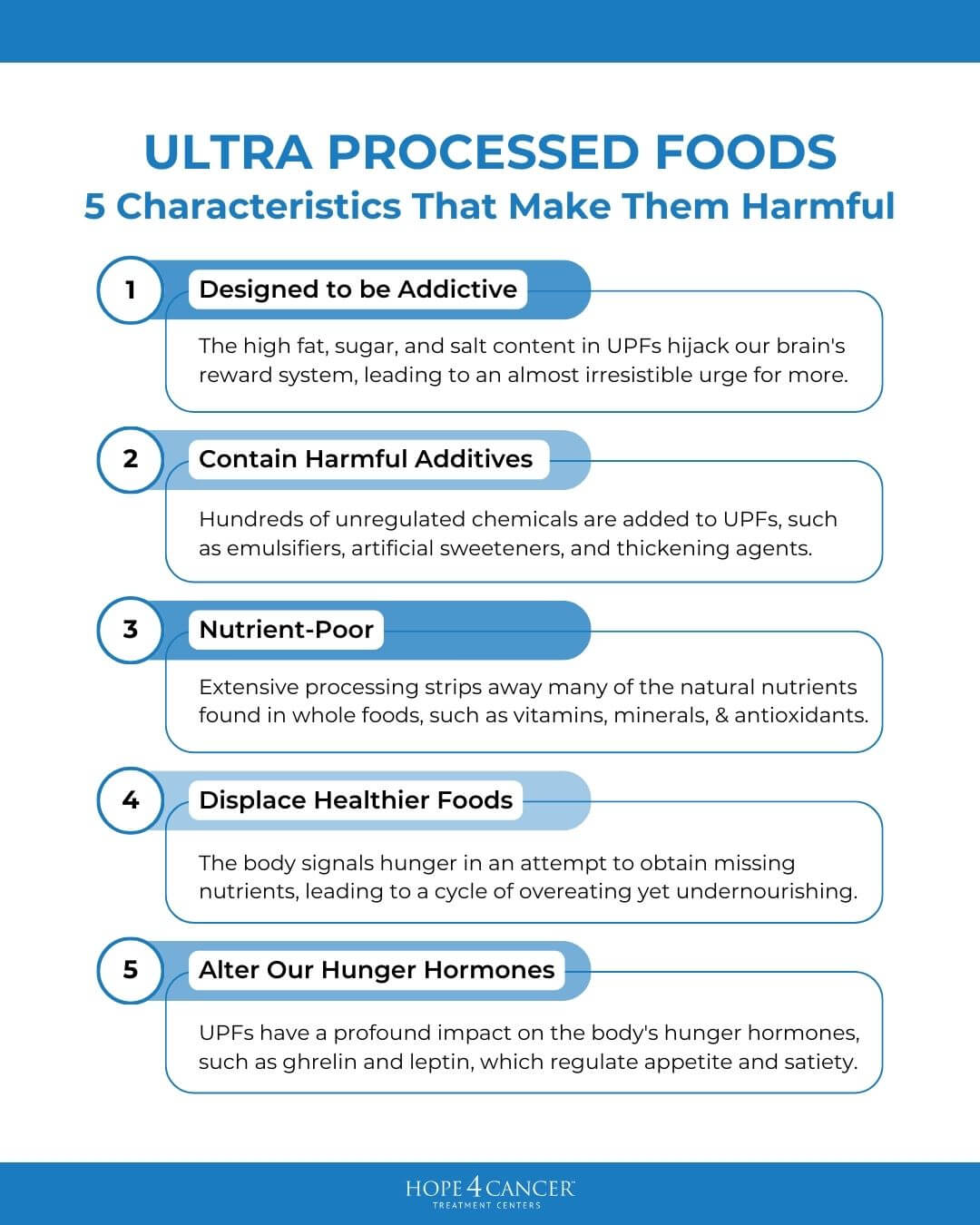We’ve all heard at some point that processed foods are bad for our health. But the term “processed foods” is quite a broad term, referring to any food that has been altered from its natural form, including cutting, cooking, or blending. The real threat to our health lies not in processed foods but in ultra-processed foods (UPFs), which have significant modifications beyond simple processing. UPFs are not merely altered but are often made from substances extracted from foods or synthesized in laboratories, including artificial colors, flavors, and preservatives. These foods are engineered to have longer shelf lives, heightened flavors, and textures that are far removed from their original, natural state. This becomes particularly concerning when you consider that a significant portion of our diet is dominated by these products. In fact, the average American consumes more than 50% of their total dietary energy from UPFs (1). It has taken many years of research to fully uncover the extent of the harm UPFs have on our health, and even now, the science is still evolving.
When Were Ultra-Processed Foods Invented?
The initial development of UPFs can be traced back to the early 20th century, with the advent of industrialization and urbanization. The need for convenient, long-lasting, and easy-to-prepare foods led to the creation of canned goods, frozen foods, and various other shelf-stable products. The World Wars, in particular, played a significant role in accelerating the production and consumption of UPFs. During this time, there was a need for food that could be easily transported, stored for long periods, and consumed with minimal preparation by soldiers.
One of the most notorious examples of UPF was developed in Nazi Germany—coal butter. This imitation butter was derived from coal byproducts through a chemical process that produced a waxy substance that spread like butter. To mimic real butter, it was infused with artificial butter flavoring and dyed yellow. Despite receiving approval for human consumption, it was later discovered to cause kidney damage, and even dogs refused to eat the substance.
Despite no longer facing the food or resource shortages of the past, companies continue to produce products like coal butter to maximize profits. By manufacturing their foods using cheap, synthetic substitutes instead of whole ingredients, they are able to significantly reduce production costs and extend shelf life. This makes these products more profitable and appealing in the market, yet it is often at the expense of nutritional value and consumer health. A good example of these cost-cutting measures can be seen with mayonnaise. Mayonnaise is generally a simple blend of eggs and oil, but because those ingredients are expensive, manufacturers have reformulated it, adding up to 15 different ingredients to create a cheaper product.
Identifying Ultra-Processed Foods
Interestingly, the criteria for what is considered UPFs is not always clear and is still evolving as food technology and nutritional science advance.
Health Issues Linked with Ultra-Processed Foods
One thing that is becoming increasingly evident is the detrimental impact of UPFs on our health. A poor diet, heavily laden with UPFs, has been identified as a leading global health risk, linked to more deaths annually than tobacco, high blood pressure, or any other health risk, accounting for 22% of all deaths worldwide (2). The consumption of UPFs is associated with a host of adverse health outcomes, including chronic inflammation, diabetes, obesity, and cancer. It poses significant risks to the immune system and is known to damage the gut microbiome. From our expertise in holistic medicine, we know that all these diseases and conditions are connected to common central changes in the body’s self-regulatory mechanisms.
Big food corporations often deflect blame for the surging health crises and obesity epidemic, suggesting that these issues stem from increased sedentary lifestyles, changes in behavior, or a collective loss of appetite control among the population. But the rise of these health issues is directly due to UPFs—and research proves it!
Studies have illuminated a stark correlation between the consumption of UPFs and the prevalence of serious health conditions, demonstrating that for every 10% increase in the intake of UPFs, there is a corresponding 10% rise in the risk of breast, prostate, colorectal, and overall cancer (3). This relationship is known as a dose-dependent effect, showcasing a clear, linear connection between the amount of UPFs consumed and the likelihood of developing these diseases. But it’s not just cancer—for every incremental increase in the intake of UPFs, there is a corresponding rise in the likelihood of obesity, cardiovascular diseases, and type 2 diabetes (4-6). These dose-dependent effects directly contradict the narrative that lifestyle factors alone are to blame for the widespread increase in illness and obesity rates.
UPFs also have a significant impact on mental health. One study linked the consumption of UPFs to a 48% higher risk of anxiety and a 44% higher risk of depression! (7) It is thought that the combined effects of these foods decrease oxygen to the brain and impact the balance of neurotransmitters, subsequently leading to higher levels of depression and anxiety.
Five Characteristics of UPFs That Make Them Harmful
The research on UPFs and health is quite compelling. But what about UPFs cause these wide-ranging negative effects? As we dive into the nature of UPFs, we uncover several key characteristics that set these foods apart from their whole-food counterparts.
⦁ Ultra-processed foods are designed to be addictive
UPFs are intentionally designed with a combination of high fat, sugar, and salt content that hijacks our brain’s reward system, leading to an almost irresistible urge for more. This manipulation of taste and texture is the result of meticulous engineering to maximize pleasure and override the natural mechanisms that signal satiety, encouraging overconsumption. The dopamine release triggered by these foods reinforces the eating behavior, creating a cycle of craving and reward similar to that seen with addictive substances (8). This strategy not only ensures consumer loyalty but significantly impacts health by promoting excessive consumption, contributing to the rising incidence of obesity, diabetes, and other chronic conditions.
⦁. Ultra-processed foods contain harmful additives
Another issue with UPFs is the hundreds of unregulated chemicals added to the food. The impact of these chemicals on our bodies has not been fully researched, but there is a lot of emerging evidence about their impact on the microbiome. Emulsifiers, acting as soap-like agents within the digestive tract, disrupt the mucous layer that safeguards the gut lining. This creates an imbalance between the “good” and “bad” bacteria in the microbiome, compromising intestinal barrier function (9). Similarly, artificial sweeteners reduce microbiome diversity and adversely affect glucose metabolism (10, 11). Thickening agents such as Xanthan gum, a sugary slime produced by bacteria, have been found to serve as food for a novel bacterial strain found only in individuals who consume it, disrupting the gut’s natural microbial balance (12).
⦁. Ultra-processed foods are nutrient-poor
To increase its shelf life, UPFs must undergo extensive processing. This strips away many of the natural nutrients found in whole foods, such as vitamins, minerals, and antioxidants, while adding ingredients like sugars, unhealthy fats, and artificial additives. The fiber content is also significantly reduced in UPFs compared to whole or minimally processed foods. This makes it harder to feel full, regulate blood sugar levels, and maintain a healthy microbiome (13).
⦁. Ultra-processed foods displace healthier foods
Even if we ignore the role of all the additives, just the fact that UPFs lose the wholesome quality and delicate nutrient balance that can only be derived from fresh foods makes them an unworthy choice for your dinner plate. Research indicates that humans and animals possess an innate ability to regulate their nutrient intake (14). However, UPFs disrupt this natural regulation mechanism due to their high-calorie content and low nutritional value. They are engineered to be hyper-palatable, encouraging overconsumption while providing minimal essential nutrients, thereby displacing healthier, nutrient-dense foods in the diet. This displacement can lead to nutritional deficiencies, as the body continues to signal hunger in an attempt to obtain missing nutrients, leading to a cycle of overeating and under nourishing. This dynamic highlights a paradox where the abundance of food does not equate to adequate nutrition, with UPFs contributing to a landscape of nutritional imbalances and escalating rates of obesity and related health issues. This phenomenon has been referred to as the “obesogenic environment” that we live in.
⦁. Ultra-processed foods alter our hunger hormones
UPFs have a profound impact on the body’s hunger hormones, such as ghrelin and leptin, which regulate appetite and satiety. These foods are engineered to be hyper-palatable, combining high levels of sugar, fat, and salt in ways that can override our natural satiety signals. As a result, consumption of UPFs often leads to an increased caloric intake because it can make us feel hungry sooner than we should. The high glycemic index of many UPFs causes a rapid spike in blood sugar, followed by a sharp decline, triggering a sense of hunger even if we have recently eaten. This disruption in the balance of hunger hormones encourages overeating and can contribute to an ongoing cycle of cravings and binge eating, further distancing us from recognizing and responding to our body’s actual nutritional needs.
Embracing an Unprocessed Future for Health and Healing
The evidence is clear: UPFs pose a serious, significant threat to our health. With their ability to manipulate our hunger signals, displace nutritious foods, and introduce harmful additives into our diets, UPFs undermine our health with every bite! Fortunately, there is a simple yet powerful solution—intentionally returning to a diet filled with whole, organic foods that come directly from the earth. Because the common underlying impact of UPFs manifests as inflammation, if you consciously choose a diet that looks similar to what our ancestors ate (full of natural, non-inflammatory foods), you can steer clear of the pitfalls associated with UPFs and embrace a diet that promotes health and healing from diseases such as cancer.
References
1. Maldonado-Pereira, L., C. Barnaba, G. de Los Campos, et al., Evaluation of the nutritional quality of ultra-processed foods (ready to eat + fast food): Fatty acids, sugar, and sodium. J Food Sci, 2022. 87(8): p. 3659-3676.
2. Chen, X., J. Chu, W. Hu, et al., Associations of ultra-processed food consumption with cardiovascular disease and all-cause mortality: UK Biobank. Eur J Public Health, 2022. 32(5): p. 779-785.
3. Fiolet, T., B. Srour, L. Sellem, et al., Consumption of ultra-processed foods and cancer risk: results from NutriNet-Sante prospective cohort. BMJ, 2018. 360: p. k322.
4. Pestoni, G., L. Habib, E. Reber, et al., Ultraprocessed Food Consumption is Strongly and Dose-Dependently Associated with Excess Body Weight in Swiss Women. Obesity (Silver Spring), 2021. 29(3): p. 601-609.
5. Qu, Y., W. Hu, J. Huang, et al., Ultra-processed food consumption and risk of cardiovascular events: a systematic review and dose-response meta-analysis. EClinicalMedicine, 2024. 69: p. 102484.
6. Delpino, F.M., L.M. Figueiredo, R.M. Bielemann, et al., Ultra-processed food and risk of type 2 diabetes: a systematic review and meta-analysis of longitudinal studies. Int J Epidemiol, 2022. 51(4): p. 1120-1141.
7. Lane, M.M., E. Gamage, N. Travica, et al., Ultra-Processed Food Consumption and Mental Health: A Systematic Review and Meta-Analysis of Observational Studies. Nutrients, 2022. 14(13).
8. Lustig, R.H., Ultraprocessed Food: Addictive, Toxic, and Ready for Regulation. Nutrients, 2020. 12(11).
9. Naimi, S., E. Viennois, A.T. Gewirtz, et al., Direct impact of commonly used dietary emulsifiers on human gut microbiota. Microbiome, 2021. 9(1): p. 66.
10. Laudisi, F., C. Stolfi, and G. Monteleone, Impact of Food Additives on Gut Homeostasis. Nutrients, 2019. 11(10).
11. Chan, C.B., Z. Hashemi, and F.B. Subhan, The impact of low and no-caloric sweeteners on glucose absorption, incretin secretion, and glucose tolerance. Appl Physiol Nutr Metab, 2017. 42(8): p. 793-801.
12. Ostrowski, M.P., S.L. La Rosa, B.J. Kunath, et al., Mechanistic insights into consumption of the food additive xanthan gum by the human gut microbiota. Nat Microbiol, 2022. 7(4): p. 556-569.
13. Gupta, S., T. Hawk, A. Aggarwal, et al., Characterizing Ultra-Processed Foods by Energy Density, Nutrient Density, and Cost. Front Nutr, 2019. 6: p. 70.



